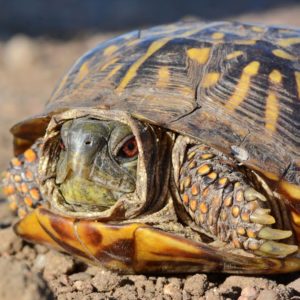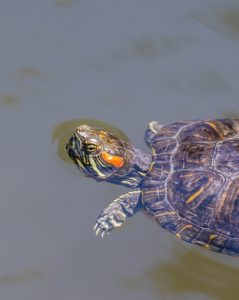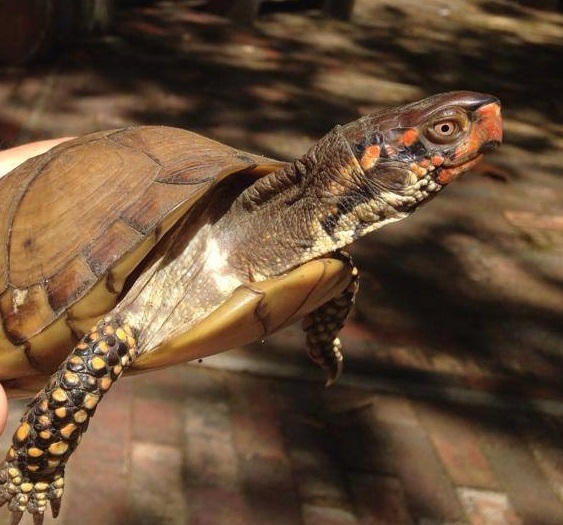Wildlife Wednesday: Common Turtles of the Nature Center
Welcome to the 3rd and final look at common reptiles of the Nature Discovery Center. This week, we review the turtles that are found here in the park. It’s a little misleading to talk about the “three most common turtles of the park”, because, while there are many turtle species found around the Houston area, we only have three species of turtle found in the park.
 The Three-toed Box Turtle (Terrapene triunguis) is our most common species of turtle, and is therefore the one you’re most likely to see. As with most box turtle species, they’re terrestrial, and tend to be associated with forested and semi-forested habitats. They are rather omnivorous, feeding on a wide variety of mushrooms, berries, flowers, insects and other small invertebrates. Also like other box turtles, their lower shell (the plastron) is hinged, which allows them to pull inside their shell and then close it up tightly. Three-toed Box Turtles usually have a caramel colored shell, which may have darker markings as well, and the males will will have various colorful markings around the face and legs. Males are larger and have reddish eyes, and the females have yellowish eyes.
The Three-toed Box Turtle (Terrapene triunguis) is our most common species of turtle, and is therefore the one you’re most likely to see. As with most box turtle species, they’re terrestrial, and tend to be associated with forested and semi-forested habitats. They are rather omnivorous, feeding on a wide variety of mushrooms, berries, flowers, insects and other small invertebrates. Also like other box turtles, their lower shell (the plastron) is hinged, which allows them to pull inside their shell and then close it up tightly. Three-toed Box Turtles usually have a caramel colored shell, which may have darker markings as well, and the males will will have various colorful markings around the face and legs. Males are larger and have reddish eyes, and the females have yellowish eyes.
Look for these turtles walking through all sections of the park.
Ornate Box Turtles (Terrapene ornata) also occur in the park, but much less frequently. These terrestrial turtles are associated more with open grassland habitats. They are omnivorous, but tend to eat more insects and small animals than other species of box turtle. They have been known to hang around cow and bison patties, and feed on the dung beetles that are attracted to them. Ornate box turtles, and indeed most North American box turtles, are inedible to humans and some other animals, because they feed on toxic mushrooms, which turns their flesh toxic (for us). Ornate box turtles have dark shells with yellowish rays on each scute (sections of the shell). The larger males often have bright olive colored heads and bright red eyes.
As far as we can tell, there is only one ornate box turtle currently in the park, and its randomly seen through the summer, walking near open areas of the parks
Just a note: With most species of terrestrial turtles, the males grow to be larger, and with most species of aquatic turtles, the females grow to be larger.
 The only species of aquatic turtle that lives in our park is the Red-eared Slider (Trachemys scripta elegans), which is also one of the most commonly encountered aquatic turtles in the Houston area. This is one of the “basking turtles”, aquatic turtles in the family Emydidae that are often seen basking in the sunshine on pond banks, rocks, and logs. Sliders are ominvorous turtles, but start out their lives as primarily carnivorous, and shift to a more plant based diet as they grow older. Despite the name, the red marks on the sides of their heads do not correspond exactly with the location of the ears. While the shells of the juveniles may be elaborately marked with yellow and green lines, the patterns fade away (eventually to black or dark gray), as they mature. Older individuals may even lose all markings and become totally black (a color condition called “advanced melanism”).
The only species of aquatic turtle that lives in our park is the Red-eared Slider (Trachemys scripta elegans), which is also one of the most commonly encountered aquatic turtles in the Houston area. This is one of the “basking turtles”, aquatic turtles in the family Emydidae that are often seen basking in the sunshine on pond banks, rocks, and logs. Sliders are ominvorous turtles, but start out their lives as primarily carnivorous, and shift to a more plant based diet as they grow older. Despite the name, the red marks on the sides of their heads do not correspond exactly with the location of the ears. While the shells of the juveniles may be elaborately marked with yellow and green lines, the patterns fade away (eventually to black or dark gray), as they mature. Older individuals may even lose all markings and become totally black (a color condition called “advanced melanism”).
Look for baby red-ears in our Cypress Pond at the South end of the park.
Well thanks for joining us for another Wildlife Wednesday, we hope you get a chance to get out into the park soon and encounter some of our fascinating native turtles.
See you soon!
Eric Duran
Staff Naturalist
Photographs: Three-toed Box Turtles by Eric Duran; Ornate Box Turtle by Andrew Dubois | Flickr; Red-eared Slider by Allan Hack | Flickr
*For any of you who are reptile enthusiasts, and perhaps confused or vexed by some our taxonomy choices, in most cases, we go by the 2016 4th Edition of the Peterson Field Guide to Reptiles and Amphibians of Eastern and Central North America by Powell, Conant, and Collins.



